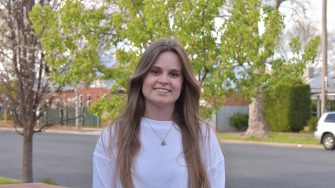You grew up in Wagga Wagga in regional New South Wales, what sparked your interest in engineering?
Growing up my family was always renovating our house, so I lived around a fair bit of construction throughout my life. Throughout this constant change in the environment around me, I developed a keen interest in how things are built and how they work. I also loved the idea of creating and inventing things and was always cutting and gluing bits and pieces of things together. Throughout school, I loved and excelled at maths and science subjects which developed my skills in more analytical thinking. When I was approaching the end of high school, I discovered engineering and found that it was the perfect mix of both creative and analytical thinking.
You're almost finished your double degree in mechanical and biomedical engineering, what have you enjoyed most about your studies, and can you explain what a double degree is?
Studying for a dual degree in mechanical and biomedical engineering has been an amazing experience. What I’ve enjoyed the most is the chance to tailor my degree by selecting subjects closely aligned to my interests which leaned more towards biocompatibility and tissue engineering rather than electronic or software components. The subjects I chose not only held my interest but allowed me to gain exposure to specific types of biomedical engineering which has helped guide what I may like to do in the future career-wise.
Throughout my degree, I have also loved being able to make friends and form connections with people who share my interests. I noticed when I started doing my specialised elective subjects that the cohort was smaller, and I was running into the same people in my classes. This made it a lot easier to form teams for group projects and make friends which made studying and getting through the more difficult parts of uni (i.e., exam season) much more bearable.
In terms of a double degree, they are a great opportunity to ensure that none of your interests are left behind. As someone who couldn’t decide between engineering and medicine, biomedical engineering allowed me to have the best of both worlds.
Double degrees allow you to study multiple areas of interest in less time than two separate degrees would take. They allow you to configure your timetable and range of classes in unique ways to suit your lifestyle in a particular term. That is, you can choose to focus on one side of your degree for a bit before switching it up or opt to take a balance of classes to keep you engaged. Double degrees also don’t mean double the workload. You still take the same number of subjects per term. Although it sounds overwhelming, the workload is the same as a single degree it’s just undertaken over a longer period.
As the recipient of a rural engineering scholarship, how did you learn about it and how has it helped you?
I first learnt about the UNSW scholarship program through their website. It was super useful with information about all the different scholarships as well as their selection criteria. I applied for as many scholarships as I qualified for and was lucky enough to receive the Graham Painton Rural Engineering Scholarship. The scholarship has allowed me to fully embrace the university experience including things like being able to live on campus when I first moved to Sydney and being involved in extracurricular activities such as playing rugby in the UNSW team. Most importantly, the scholarship has allowed me to have all of these amazing opportunities while still providing me the time to spend on my uni courses and to focus on my academics. I’m also lucky enough to have a scholarship that is funded by a foundation, so having the opportunity to meet the people behind my scholarship and share the tangible impact it has had on my life has been very rewarding over the years.

